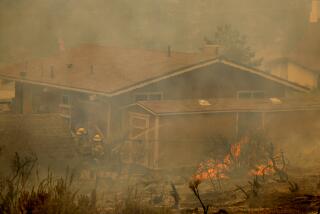Letters: Cleaning up after the Rim fire
Re “Beware the clear-cutters,” Editorial, Oct. 4
Your editorial calls a bill in the House of Representatives to reduce the risk of forest fires a “flawed approach,” but it then goes on to suggest that no policy changes are necessary to address the atrocious conditions in our national forests.
The Times suggests that aggressive thinning and rapid salvage are needed to reduce fire danger, noting that “current rules require timber companies to wait too long.” That is precisely why we need legislation like HR 1526: to clarify the U.S. Forest Service’s management mandate on a portion of the national forest system.
Those in the timber industry who still rely on the national forest system for wood supplies are actively engaged in the “talking groups” that The Times touts as part of the solution. Yet time and again, we find the Forest Service unable to implement the management these groups call for. Instead, it engages in endless analysis, which then gets second-guessed by the courts.
This approach lets forests die, burn and regrow into brush fields. This doesn’t benefit us or our neighbors downstream.
Bill Imbergamo
Washington
The writer is the executive director of the Federal Forest Resource Coalition.
Although clear-cutting is not the appropriate response to the Rim fire, there are important lessons to be learned.
Many people don’t realize how important forests are to our well-being, especially as a source of half our nation’s water supply. Mega fires like the Rim blaze can cause long-term damage to water supply, recreation and wildlife.
Our forests are overly dense with brush and small trees due to past management, which has led to a greatly heightened risk of destructive wildfires.
Rather than spending hundreds of millions of dollars to fight mega-fires and repair their damage, we should take proactive steps to reduce the risks. Ecologically based thinning and controlled burns are proven, cost-effective solutions to make our forests safer and healthier for people and nature.
By investing in restoring our forests to a more natural condition, we can make them safer when fires occur, which makes economic and environmental sense.
David Edelson
San Francisco
The writer directs the Sierra Nevada Project for the Nature Conservancy.
It’s just plain wrong for fire-burnt forests to be denied their future renewal in the way they were created to renew themselves.
Their having been damaged doesn’t give anyone the right to slip in — promising short-term economic gains — and steal the possibility of a legitimate, authentic regrowing habitat that in its diversity can support many plants, animals, birds and insects.
No fire sales, please.
Maggie Blankley
Los Angeles
ALSO:
Letters: No solutions, no Mideast peace
Letters: Malala Yousafzai’s youthful wisdom
Letters: Star power gave us Gov. Schwarzenegger
More to Read
A cure for the common opinion
Get thought-provoking perspectives with our weekly newsletter.
You may occasionally receive promotional content from the Los Angeles Times.










